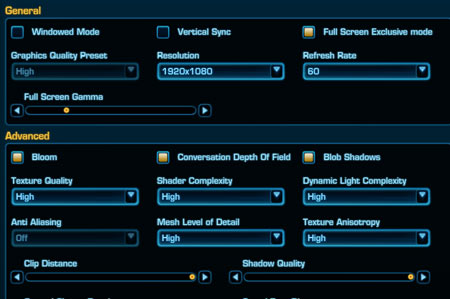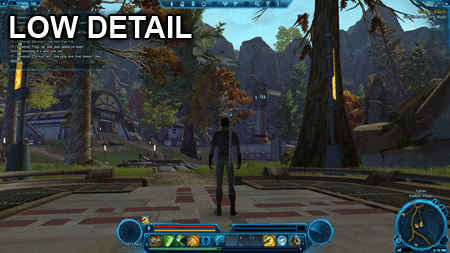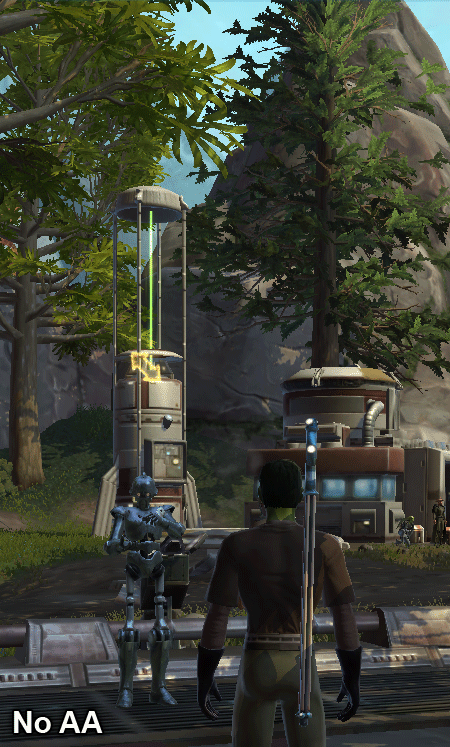Star Wars: The Old Republic: PC Performance, Benchmarked
Rarely are MMOs anticipated as hotly as Star Wars: The Old Republic. We take a close look at the offspring of legendary developer Bioware and the larger-than-life Star Wars franchise, then tell you what kind of hardware it needs for smooth performance.
Image Quality And Settings
The game is built using Simutronics’ HeroEngine, licensed to Bioware Austin. Our testing shows that there are two graphics options that affect performance in a significant way: bloom and shader detail. The other settings don't appear to have as much impact on performance, even at the maximum setting.
Unfortunately, when the shader detail setting is lowered, shadows disappear (except for subtle blobs). Here is how the game looks at its Low preset (with bloom disabled and the shader level set to low) compared to the High setting (with bloom enabled and the shader level maxed out).
As you can see, the depth afforded by shadows adds a lot to the game, and high detail is obviously superior. Our one complaint is that shadow resolution is very blocky, regardless of detail setting, and when your character walks under a tree, it appears to be covered in grey blocks. In any case, similar to World of Warcraft, the cartoonish art is acceptable at low detail settings, so folks with low-end hardware can still enjoy the game.
Like all games, Star Wars: The Old Republic benefits from anti-aliasing. This is where things get a little complicated. The in-game anti-aliasing setting is disabled in the beta, so we had to find a workaround. Forcing AA through AMD's Catalyst driver worked, but it didn't on Nvidia's GeForce-based cards. A bit of research revealed that 4x MSAA could be forced in-game using the title's client_settings.ini file by adding the line “AntiAliasingLevel = 4”. This tweak worked with the Nvidia cards, but then wouldn't on AMD's (except for newer Radeon HD 6900-series boards). Despite the anti-aliasing mess, which will hopefully be worked out soon, we're at least able to test the game with the feature enabled on all hardware, albeit through different means.
Unfortunately, there are a lot of transparent textures in the game that don’t benefit from multi-sample anti-aliasing. The good news is that both AMD’s Adaptive AA and Nvidia’s Transparent AA work with this title. As you can see in the comparison shot above, transparency anti-aliasing really improves the quality of foliage, even if the benchmarks demonstrate its adverse effect on frame rates.
Get Tom's Hardware's best news and in-depth reviews, straight to your inbox.
Current page: Image Quality And Settings
Prev Page The Old Republic: A Little Backstory Next Page Test System And BenchmarksDon Woligroski was a former senior hardware editor for Tom's Hardware. He has covered a wide range of PC hardware topics, including CPUs, GPUs, system building, and emerging technologies.
-
hpglow Tom's you get bought out by Best of Media, and now the news is a couple days old and stale, we get anoying pop-ups over what we are reading every 3 pages or so, and there are very few cards in this write up. Why do I keep coming here to read stuff? I'm just going to take you guys out of my queue of reads every day you need to go back to what made you profitable.Reply -
Looks like my GTX 460 will handle the game fine. Playing in the tester weekend beta really made me look forward to playing the game.Reply
-
jellico Ran the game on very high, max viewing distance with:Reply
i7-2600K
Radeon HD 5850
I played with high settings and a 3/4 viewing distance with:
Core 2 Duo e840
Nvidia GTS 8800
I played with with a mixture of low and medium settings and 40% viewing distance with:
i5 - 750
Radeon HD 4670
So clearly, a better video card (even an older one) is more important than a top-end processor.
This is a great game! Every quest and NPC interaction has voice-overs which greatly add to the dimension of the game. The intro movies are the best I've seen of any game, ever! -
hokkdawg I just KNEW this game wouldn't live up to the hype. It has a great single player RPG component, but it really doesn't need to be an MMO. It's like LOTRO - that game is great when sold as a single RPG to play offline, or even with P2P multiplayer. But as an MMO? Totally not worth the monthly fees. Time will tell with SW:TOR, but it sounds like the single player is the primary selling point...and the venture into MMO territory is nothing but a ploy to rake in more income from monthly fees...Reply -
hardstylerz So people were fine about the performance of this game but complained about the performance of crysis? which looks a million times better than this...The game looks worse than world of warcraft and yet runs like absolute crap. I smell another ploy to push up sales for graphics cards. YOu can't be serious about the performance of this game. Even skyrim looks better and plays better despite being a console port.Reply -
As a subscription based game, BioWare can continually add content, and it doesn't hurt to be able to group with people for tough encounters or just because you enjoy it.Reply
-
SirGCal I was on the beta. Thought my system is a bit overkill (OCd 1100T & 6970), it ran like butter with everything maxed and the AA trick activated.Reply
Still, I'm excited for release. I had a lot of fun in the beta and world PVP seems interesting without being annoying (though time will tell when the whole public gets ahold of it). You can solo much of it, but there are mini-raids starting at level 10 (or flashpoints I think they were called)...
The stories were just... wow... Sometimes they went a bit weak but they were always so detailed. I can say that this wouldn't be nearly as good as a single-player RPG. Lots of social aspects going on. But it's also not a grind like any other MMO I've done... Never once did I feel the grind of 'go kill 20 of these, bring the eye. go kill another 20, bring the teeth (why didn't they tell me last time).' Infact, kill X anything was a very rarity accept for a bonus xp aspect of which you nearly always doubled before finishing anyhow.
The big question is; "Will it have a good end-game"... Cause if not (and we didn't get to test that far), then long-term playability will be very limited... But again, we'll see that very soon... -
Will I lag with a low end graphics card in lets say a city or an instance? What would u recommend the minimum graphics to do such things and have a good experience?Reply
-
Yargnit Perfect timing, I've been trying to decide between a 6950 and 560ti for a new SWTOR rig to get for Xmas. Wish you had tested these specific cards, but this certianly helps still. I've always prefered Nvidia's cause of better drivers, but this makes it real hard to take a 560ti over a 6950.Reply
Just wish you ran a 1gb/2gb card test. I've seen SWTOR eat tons of memory (2.7GB) & I wonder if video RAM is the same way.


